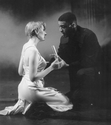
by
Vicente Forés
During the next 7th World Shakespeare Congress to take place in Valencia in April of 2001, where Titus will be one of the Shakespearean plays we are going to hear a lot about, probably too much for some peoples disliking of the play. We hope to be able to show "Titus" by Julie Taymor, as well as enjoy her presence in Valencia. She is one of the keynote speakers of the Congress, and as in show-business I hope this little indiscretion (even it is virtually already known world-wide) will not abort the project. At another place of this same issue we can hear Julie Taymor explain herself through her Director's notes that were first published with the rest of promotional materials by Fox Searchlight Pictures and Clear Blue Sky Productions (1)It was more than an extraordinary present, not just a coincidence, that "Titus Andronicus" by Shakespeare should be the film that a person like Julie Taymor could be interested in directing. Her artistic personality combines all the necesary ingredients for the aesthetics and the conception of what she wants to reach the audience. Let's know her a little bit better through what she herself must say to us:
Elizabeth Snead in her 'Pulp Shakespeare' article lets Julie Taymor say:
"I gravitated to the best writer in the English language with an important story to tell, I don't think there has ever been anything written on the dual nature of man as deep and thorough as Titus, It puts all modern explorations of violence to shame." (2)The time is a created time. You can't say, like in "Richard III," that it's the 1940s ... it's a blend of time. Now, about how you'd have Bassianus in a 1950s Thunderbird and Saturninus in Mussolini's convertible ... and Titus in a chariot [that] has more to do with that character. That costume and period feel of the music was more of an essence of who they are as people ... Costume is about personality, not about OK, now we're in the '50s, now we're in the '90s, now we're in the '80s.
He's a genius. The man understood human nature better than anybody. You look at something like "Titus," his first play, and it's so rich in comprehension of what makes human beings do what they do. So I think people can put on layers for later generations ... but he understood human nature. That's why these are great plays. You can't say that we make them good plays by our understanding of them. It's all in the text, every single bit of it is in the text ... He was a brilliant writer of his time, and his time is oddly very close to our time. Young people have really dug it. The distributors were surprised, since it's Shakespeare. But hello! Look at what kind of Shakespeare it is. The inner-city high school students went berserk when I played it for them ... They said, "Move over Schwarzenegger, here comes Titus." Confesses Julie Taymor to Sasha Emmons, in "Having Words with Julie Taymor". (3)
From Jacques Lecoq to The Lion King(4) is the title of an interview by Richard Schechner, which provides us with a collection of images, of which we want to select the following four, because we think they reveal, in the easiest and most direct way a lot of the esthetics employed in this movie.
Figure 9. In Taymor's 1994 stage production of Titus Andronicus, Tamora (Melinda Mullins) and her lover Aaron the Moor (Harry Lennix) plot to kill Bassianus, the emperor's brother.

Figure 10. Julie Taymor and Anthony Hopkins (Titus) confer between takes of the crossroads scene in TITUS, the 1999 film version of Taymor's Titus Andronicus.
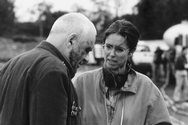
Figure 11. A bound Aaron (Harry J. Lennix) arrives at the Goth camp with his infant son slung on his back in TITUS (1999).

Tut, I have done a thousand dreadfull things
As willingly, as one would kill a Fly,
And nothin greeves me hartily indeede,
But that I cannot doe ten thousand more. (V.i.146-150).Figure 12. The emperor, Saturninus (Alan Cumming), sits on his throne beneath a giant sculpture of the wolf, the emblem of Rome, in Taymor's film, TITUS (1999).
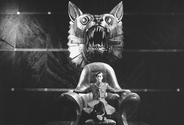
On a different occasion we hear Julie Taymor say (5) that she only works on a few projects at a time. For her quality definitely is more important than quantity. Even if she is considered to be a great theater director, many consider her to be one of the greatest living and revolutionary puppet artist. Her career, now that people will start knowing her as a film director, consists of much more than her operating as a "puppeteer," a term which she despises. She says:Sounds like a mousketeer. . . . It's an easy peg, but I've never been a puppeteer, I conceive and I write and I design and I direct. And not just puppets. I direct actors, I direct dancers, I direct singers, I direct films. I also direct puppeteers.
I'm really a theatre maker, but there's not a word for that. (Reardon 10). (6)And about how she works she says:
It's very exhausting. . . I can't design a mask and say to someone else, "Just do it." It's partly because I'm a better sculptor than I am a drawer. Considering the amount of time it would take me to draw exactly what I want, I might as well sculpt it. I paint most of it too. It's incredibly time consuming so I end up turning down a lot of jobs I want to do. (Shewey 72) (7)
Taymor demonstrates how the puppet can achieve things that an actor could not. This recognition is important, the idea that there are things which puppets can do much better than actors. In 1986, Taymor staged a production of William Shakespeare's The Tempest at the Theatre for a New Audience in which she utilized both puppet and mask. When the storm starts a screen falls from upwards and a cutout is projected, illuminated by a luminic source which is moved at the same time by the light operator, and an abstract storm effect is achieved by means of an easy game of shadows.
Perhaps Taymor's most innovative contribution to the production is her handling of Ariel. She decided to have Ariel represented by a hand-held mask and a costumed hand, which would be manipulated by an operator garbed in all black, much in the same way as a left hand or foot operator of a Japanese bunraku puppet. She says of this decision:Ariel is described as a spirit. . . I kept wondering "How do you really get the essence of a spirit?". . . That this [hand],
with this face could express all of the human emotions which this spirit has, and yet is not a human. ("Behind the
Scenes" Video) (8)Taymor's decision was made in order to capture the essence of a non-human creature, and this says much for the power of puppetry in her performance. Rather than use a human to portray the spirit, Taymor has opted for the magic of puppetry.
The mask is also very important in Taymor's production. It is important to note the strong power that the mask has in this performance in terms of control. The actress playing Ariel is masked as a bunraku operator, and Caliban is masked in a "stone" mask (which is Taymor's interpretation of Shakespeare's line: "Here you sty me in this hard rock"). When Caliban decides to revolt against Prospero, he breaks open the mask with a stick, and when Ariel is finally freed by Prospero, the actress removes the mask and reveals her face for the first time. The mask represents enslavement for the spirits, and its removal reveals their inner self. The whole idea can perhaps be looked at as a metaphor for puppetry. Until their freedom, the spirits were little more than puppets to Prospero. Perhaps representative of the "magic" contained within a puppet.
© Dr. Vicente Forés
Universidad de Valencia




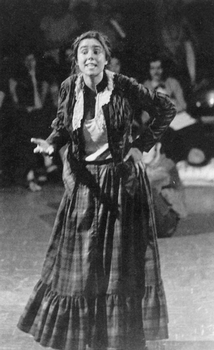


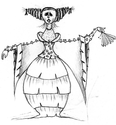
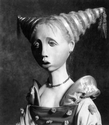

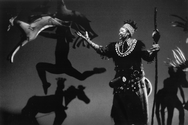
Notes
1 Presented in association with the Overseas Filmgroup, "Titus" the feature film directorial debut of Julie Taymor, who also wrote the screenplay.2 Julie Taymor's 'Pulp Shakespeare' by Elizabeth Snead, USA TODAY, 02/08/00, in http://www.usatoday.com/

3 From Jacques Lecoq to The Lion King, an interview by Richard Schechner, published in The Drama Review 43.3 (1999) http://muse.jhu.edu/journals/4 Sharing The Story Within -- An Interview with Julie Taymor,by Joel Snyder, National Endowment for the Arts, at http://www.arts.gov/index.shtml
5 Sagecraft Productions Presents, at THE PUPPETRY HOME PAGE, Julie Taymor as Puppet Artist, by James M. Brandon;
at http://www.sagecraft.com/puppetry/6 Reardon, Christopher. "Theatre Director Probes Humanism." Christian Science Monitor. 13 Nov. 1992: 10.
7 Shewey, Don. "The Lively Arts." Connoisseur. 219 (1989): 70-78.
8 "Behind the Scenes." Dir. Houde, Ellen, and Meyer, Muffie. PBS Video. 30 min. 1992.
Página creada y actualizada por grupo "mmm".
Para cualquier cambio, sugerencia,etc. contactar con: fores@uv.es
© a.r.e.a./Dr.Vicente Forés López
© Fundación Shakespeare de España